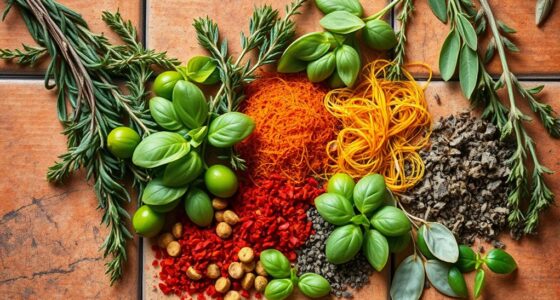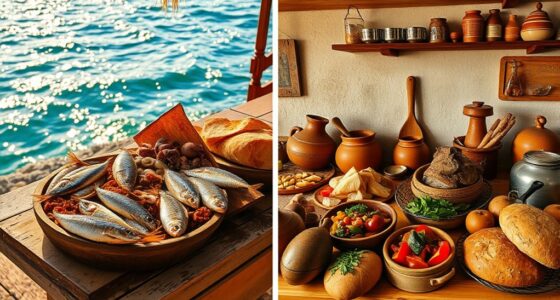To host a Sardinian-style dinner at home, start by gathering authentic regional ingredients like Pecorino Sardo, fregola, fresh seafood, and local herbs. Plan a menu with traditional dishes such as culurgiones, favata, and fregola with calamari. Prepare hearty starters and rustic main courses, then finish with classic desserts like Seadas. Set a cozy, rustic atmosphere with handmade decor, traditional music, and warm lighting. Continue exploring ways to bring Sardinia’s rich culinary traditions to your table.
Key Takeaways
- Plan a traditional Sardinian menu featuring regional dishes like culurgiones, fregola with seafood, and Seadas for dessert.
- Source authentic ingredients such as Pecorino Sardo, carasau bread, fresh seafood, and regional honey.
- Decor your space with rustic Sardinian elements like terracotta pottery, woven textiles, and handcrafted wooden furniture.
- Play Sardinian music like launeddas and vocal chants to create an immersive cultural atmosphere.
- Serve dishes on wooden boards and terracotta ware, and include regional wines and homemade liqueurs for an authentic touch.
Gather Authentic Sardinian Ingredients and Supplies
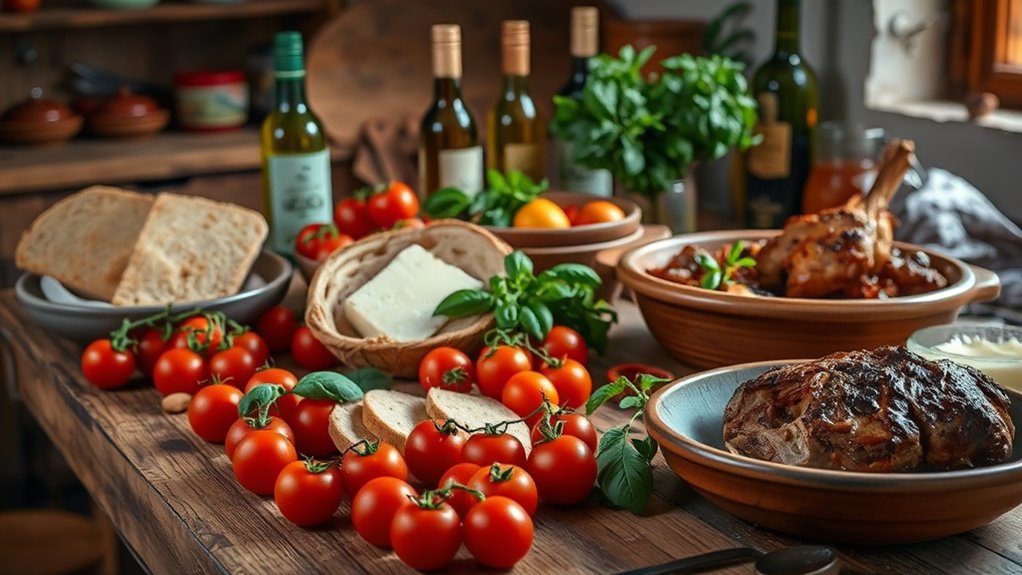
To create an authentic Sardinian dinner, start by gathering the region’s key ingredients and supplies, focusing on seafood, cheeses, breads, vegetables, and herbs. Fresh seafood is essential—look for sea urchins (ricci di mare), calamari, clams, and king prawns, all crucial for seafood dishes. Pick up high-quality Sardinian olive oil to flavor your sauces and dressings. For cheeses, guarantee you have Pecorino Sardo and fresh ricotta to add authentic flavor to your dishes. Don’t forget to include Sardinian staples like carasau bread and fregola pasta, perfect for pairing with seafood. Vegetables like artichokes, tomatoes, and wild herbs such as fennel and rosemary provide aromatic accents. Incorporating traditional Sardinian culinary techniques can elevate your cooking and bring genuine flavors to your table. With these ingredients, you’ll be well-equipped to prepare a genuine Sardinian feast. Sardinia has a rich culinary tradition rooted in local ingredients that reflect its pastoral landscape and maritime heritage.
Plan a Menu Featuring Traditional Sardinian Dishes
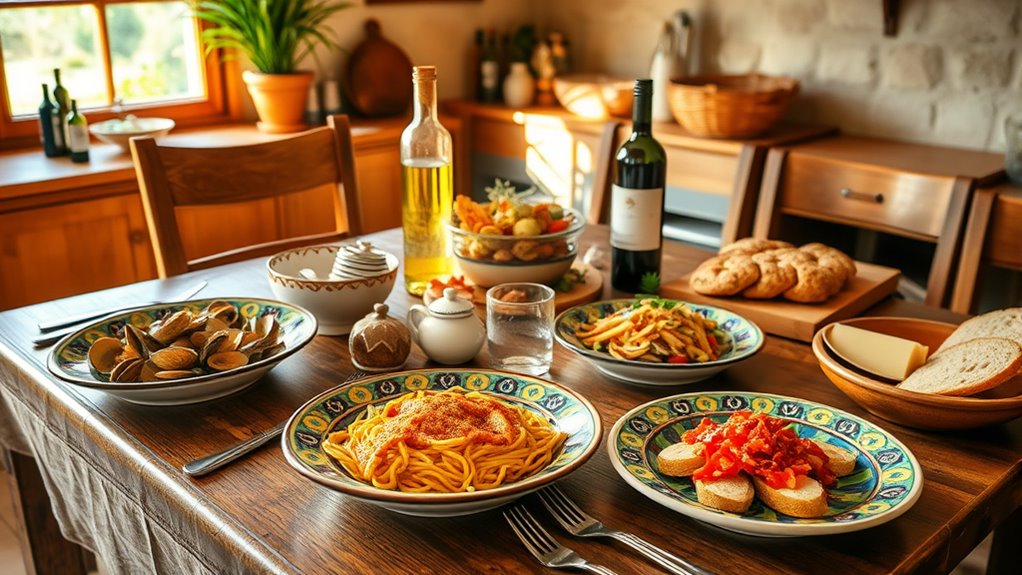
With your ingredients in hand, it’s time to craft a menu that highlights Sardinia’s rich culinary traditions. Focus on hearty stews, flavorful pasta, and comforting pies. For starters, serve Culurgiones, cheese and potato dumplings with tomato sauce. Main courses can include Favata, a savory bean and pork stew, or Panada, a lamb-filled pastry. For pasta, try fregola with clams or malloreddus with lamb ragù—both showcasing Sardinia’s unique flavors. Finish with Gallurese soup or herb-based bean soups for warmth and health benefits. Traditional ingredients and culinary style are central to these dishes, emphasizing simple, local produce and rustic preparation methods. Incorporating culinary techniques that honor Sardinian traditions will elevate your menu and provide an authentic experience. Here’s a sample menu to inspire:
| Appetizer | Main Course | Pasta & Soup |
|---|---|---|
| Culurgiones | Favata | Fregola with clams |
| Artichoke salad | Panada | Gallurese soup |
| Herb bean soup | Sardinian stew | Minestrone |
Prepare Classic Appetizers and Starters to Impress
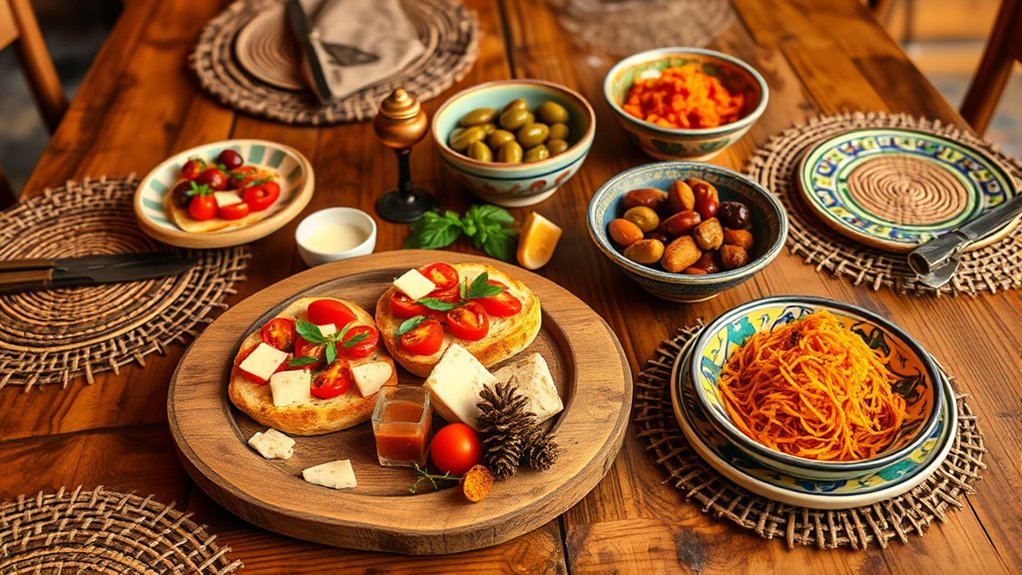
Crafting impressive Sardinian appetizers begins with selecting vibrant, authentic ingredients that showcase the island’s rich culinary heritage. Focus on mushrooms, pickled olives, artichokes, and peppers, which feature prominently in traditional starters. Incorporate cured meats like wild boar ham, bacon, sausages, and salami from Irgoli, pairing them with pecorino cheese for rustic appeal. For seafood starters, prepare shellfish salads with clams, shrimps, and olives, or serve mussels cooked with saffron or laurel. Vegetarians can enjoy raw shaved artichoke salads seasoned with lemon and olive oil or fried zucchini flowers. Use wooden boards to serve cured meats and cheeses, and include carasau or pistoccu bread for added texture. These vibrant, well-presented appetizers will immediately impress your guests. Additionally, incorporating regional specialties like bottarga can elevate your starter selection, offering a unique taste of Sardinia’s delicacies. To ensure the presentation matches the authenticity, consider using self watering plant pots to display fresh herbs and garnishes, adding a touch of greenery and elegance to your table.
Cook Hearty Main Courses With Regional Flavors
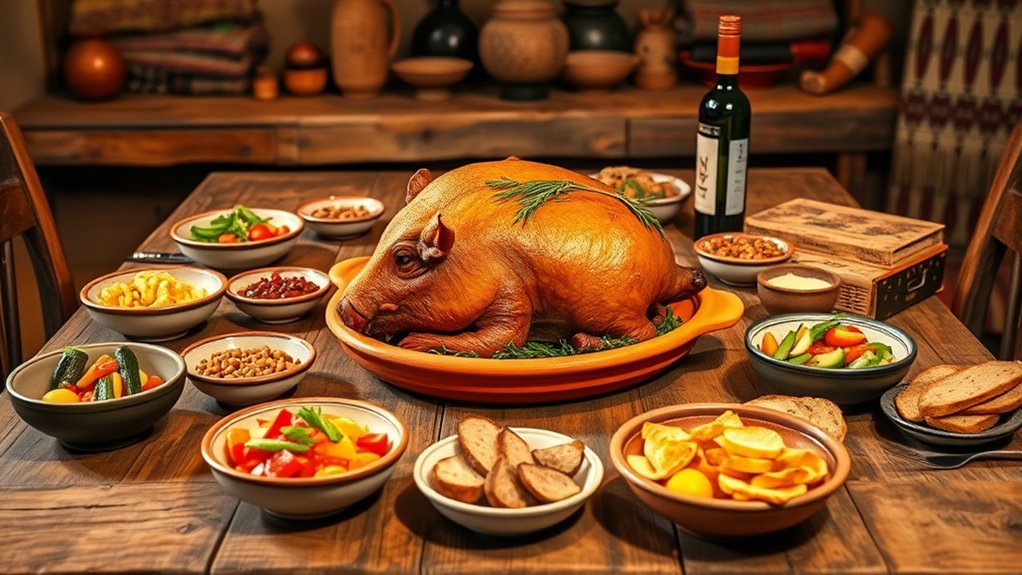
Sardinian main courses are celebrated for their bold flavors and reliance on regional ingredients. You can create hearty dishes like favata, a rich stew of dried broad beans, pork, vegetables, and wild herbs, sometimes enhanced with dried sausage. Another option is panada, a savory pastry filled with lamb, potatoes, and dried tomatoes, perfect as a main. For colder months, serve gallurese soup—baked bread layered with pecorino cheese and meat broth. Modern reinterpretations like paella algherese use fregola, Sardinian pasta, combined with calamari, clams, prawns, chicken, and sausage. You can also experiment with lasagne made from crispy carasau bread layered with pork and mushroom sauce. Incorporate regional ingredients like pecorino, bottarga, and wild herbs to truly capture Sardinia’s hearty, rustic flavors. Sardinia is known for its unique culinary traditions that emphasize simple, natural, and locally sourced ingredients. Additionally, exploring regional culinary techniques can help you authentically replicate traditional Sardinian dishes at home.
Create Delicious Sardinian Desserts to Finish the Meal

Start your dessert with classic Seadas, deep-fried pastries filled with ricotta and drizzled with local honey. Incorporate citrus-infused flavors, like lemon or orange zest, into other sweets to highlight Sardinia’s bright, fresh notes. These desserts perfectly finish your Sardinian feast with authentic, flavorful sweetness. Traditional Sardinian pardulas, with their golden hue and saffron aroma, are also a delightful way to conclude your meal. Additionally, choosing merchant services that support secure and efficient payment processing can make hosting and selling these treats at a gathering more seamless.
Classic Seadas Recipe
To make authentic seadas, begin by preparing a delicate dough that combines all-purpose flour and durum wheat semolina, then incorporates lard for crispness and a touch of salt or sugar for balance. Mix these ingredients thoroughly, add warm or cold water to achieve the right consistency, then knead until smooth. Let the dough rest in the fridge for at least 30 minutes to improve elasticity. Proper dough handling is essential to achieve the desired texture and appearance. When ready, roll the dough into thin disks, place a small amount of grated pecorino or Dolce Sardo cheese mixed with lemon zest on one half, then moisten the edges and fold to seal. Use a fork or fingers to press and secure the edges, ensuring the filling stays inside during frying. – Rest shaped seadas before frying – Use high heat for quick sealing – Seal edges carefully to prevent leakage – Keep dough thin for crispiness – Fry until golden, about 3-5 minutes
Incorporating Local Honey
Incorporating local honey into Sardinian desserts elevates their flavor and authenticity, as the regional varieties bring unique aromatic notes that can’t be replicated elsewhere. Sardinian honey, especially from *corbezzolo* (strawberry tree), offers a distinct bittersweet flavor that balances rich or creamy ingredients like sheep’s milk cheese and ricotta. Use honey-water infusions—simmered with orange peel—to glaze pastries, adding aroma and moisture. Warm honey can be drizzled over fried or baked treats, enriching their texture. Pair honey with cheeses like Pecorino to create a harmonious sweet-salty contrast. By choosing regional honey, you support local beekeepers and preserve Sardinian culinary traditions, ensuring your desserts truly capture the island’s authentic flavors. Additionally, understanding the regional honey varieties can help you select the most authentic and flavorful options for your desserts.
Citrus-Infused Desserts
Citrus-infused desserts offer a bright and aromatic finale to a Sardinian meal, highlighting the island’s rich citrus heritage. These treats showcase the vibrant flavors of local lemons, oranges, and the unique pompia fruit. You might enjoy:
- Traditional Pardulas with ricotta, saffron, and lemon or orange zest, baked to golden perfection.
- Seadas filled with cheese and topped with honey or sugar, complemented by pompia zest for a hint of bitterness.
- Almond pastries and meringues flavored with lemon or orange zest, adding freshness to nutty and crispy textures.
- Crema Catalana, enriched with lemon and orange zest, finished with a caramelized sugar crust and saffron for aromatic depth.
- Citrus zests, often used in various desserts, create a lively, regional flavor profile that highlights Sardinia’s citrus roots.
- Incorporating colorful citrus garnishes can elevate the presentation and enhance the citrus aroma in your desserts.
Set the Atmosphere With Rustic Decor and Music
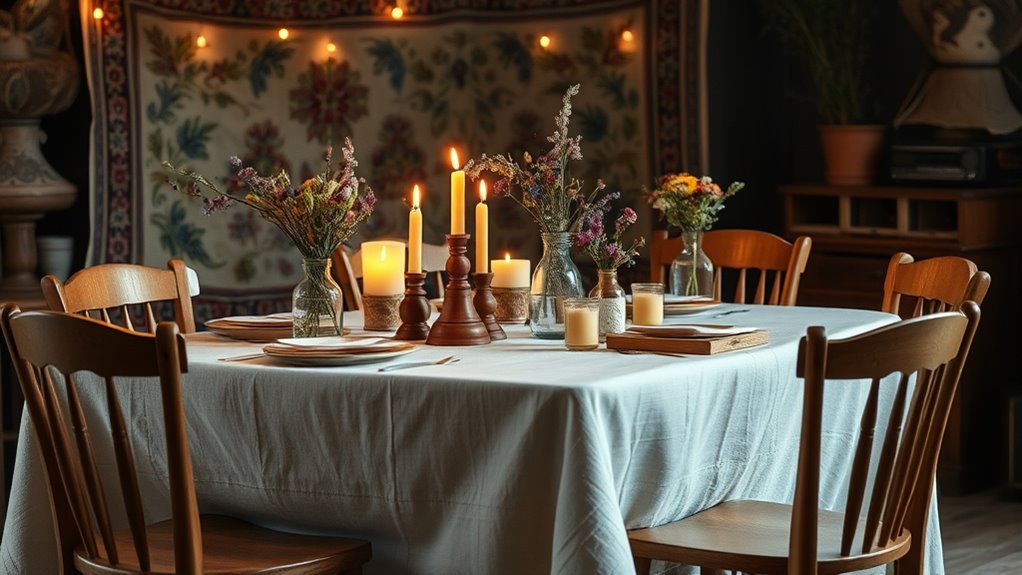
To create an authentic Sardinian atmosphere, focus on rustic decor elements like natural wood, terracotta, and woven textiles that reflect the island’s artisanal craft. Incorporate traditional music, such as launeddas or vocal chants, to evoke the region’s rich cultural heritage. Set a cozy, warm scene with soft lighting and handcrafted tableware to complete the rustic, inviting vibe. Additionally, including small decorative items like Nuraghe replicas or traditional Sardinian ceramics can further enhance the regional ambiance Nuraghe stone structures. Incorporating local craftsmanship details can also add a genuine touch to your decor.
Authentic Sardinian Decor Elements
Creating an authentic Sardinian atmosphere starts with selecting rustic decor elements that reflect the island’s rich craftsmanship and natural materials. Focus on items that showcase traditional techniques and earthy textures. Incorporate handcrafted wooden furniture with detailed carvings, and use terracotta pottery and tiles to add warm, rustic charm. Woven wool textiles, like rugs and blankets with geometric motifs, bring comfort and symbolism to the space. Cork crafts, such as coasters or decorative objects, highlight Sardinia’s artisanal heritage. Finally, add baskets and containers made from wicker and plant fibers for a rural touch. These elements are rooted in centuries of tradition and craftsmanship, combining to evoke Sardinia’s natural beauty and craftsmanship, creating a warm, inviting setting that celebrates the island’s unique cultural identity. Additionally, incorporating authentic Sardinian decor items can further enhance the overall atmosphere and make your dinner truly special.
Traditional Music and Instruments
Introducing traditional Sardinian music into your dinner setting instantly transports guests to the island’s rustic charm. The launeddas, a distinctive three-cane wind instrument, creates a mesmerizing drone and intricate melodies that evoke Sardinia’s cultural roots. Its complex circular breathing technique and finger coordination may take years to master, but even recordings provide authentic ambiance. Complement the launeddas with other instruments like drums (*tumbarinos*), jaw harps (*scacciapensieri*), and simple flutes (*benas*) to enrich the soundscape. Historically dating back to the Nuragic era, this music has always been integral to festivals, religious ceremonies, and communal gatherings. Playing or playing recordings of launeddas and traditional ensemble sounds instantly sets a festive, communal atmosphere, immersing your guests in Sardinia’s rich musical heritage. Evidence suggests similar instruments have existed since ancient times, adding depth to the cultural authenticity of your ambiance.
Cozy, Rustic Dining Setting
Setting the scene with rustic decor transforms your dinner into an authentic Sardinian experience. You can achieve this by choosing furniture made from natural materials like chestnut or reed woods, featuring handwoven or carved details. Incorporate traditional Sardinian chairs such as “Ines,” “Nannai,” or “Lia,” known for their artisanal charm. Use simple, sturdy dining sets with earthy tones and modern touches like glass tabletops. Add warmth with textiles made from wool and cotton—think hand-tufted rugs and patterned cushions. Enhance the ambiance with:
- Handmade ceramics in earthy, organic shapes
- Terracotta dishes and accents
- Soft candlelight or small oil lamps
- Wrought iron or wood lighting fixtures
- Olive branches or dried herbs as natural centerpieces
This combination creates a cozy, rustic atmosphere full of island authenticity.
Frequently Asked Questions
How Can I Find Authentic Sardinian Ingredients Outside Sardinia?
You can find authentic Sardinian ingredients outside Sardinia by exploring specialty Italian and Mediterranean stores, both physical and online. Look for key items like pecorino sardo, bottarga, carasau bread, and fregola pasta. Joining Italian culinary groups or attending regional food festivals can help you connect with trustworthy suppliers. When sourcing, prioritize preserved or dried ingredients, and consider local substitutes when authentic products aren’t available to maintain that genuine Sardinian flavor.
What Wine Pairs Best With Sardinian Dishes?
Ever wonder which wine truly complements Sardinian dishes? You should consider Vermentino di Gallura for seafood, thanks to its bright acidity and citrus flavors. For hearty red meats or game, Cannonau di Sardegna offers bold tannins and spice. If you’re serving cheeses or desserts, Moscato di Sardegna or Vernaccia di Oristano are excellent choices. Matching these wines enhances the authentic flavors of Sardinian cuisine at your table.
Are There Vegetarian Sardinian Recipes I Can Include?
You can definitely include vegetarian Sardinian recipes in your dinner. Think hearty minestrone with fresh herbs and fregola, or a vibrant insalata di finocchi e arance for a invigorating starter. Grilled vegetables like Verdure Grigliate or stuffed eggplants with Pecorino add flavor. Legume-based dishes, such as chickpea soup or fava bean stews, offer protein and tradition. These dishes showcase Sardinian flavors while keeping it vegetarian-friendly.
How Long Does It Typically Take to Prepare a Sardinian Dinner?
Preparing a Sardinian dinner can take anywhere from a couple of hours to over five hours, depending on the dishes you choose. Traditional recipes like culurgiones and porceddu require extensive prep and slow cooking to stay authentic. To save time, you might opt for simpler dishes like fregola or antipasti. Remember, multiple courses and slow-cooked ingredients extend the meal duration, so plan accordingly to enjoy the full Sardinian experience.
Can I Make Traditional Sardinian Dishes Ahead of Time?
Yes, you can definitely make traditional Sardinian dishes ahead of time. You can cook pasta like fregola and malloreddus in advance, store sauces, and even prepare meat and seafood components early. Just keep in mind that seafood is best assembled close to serving, and bread-based dishes should be fresh or assembled last minute to maintain their texture. Proper storage and reheating will guarantee your dishes stay flavorful and authentic.
Conclusion
Hosting a Sardinian dinner is like opening a window to a vibrant island culture. When I first tried making seadas at home, the aroma instantly transported me to a rustic Sardinian village. With authentic ingredients and a bit of passion, you turn your kitchen into a Mediterranean haven. Just like Sardinia’s timeless traditions, your meal will create warm memories that linger long after the last bite. Embrace the journey, and enjoy bringing Sardinia to your table.




